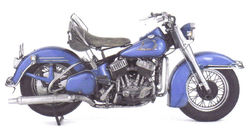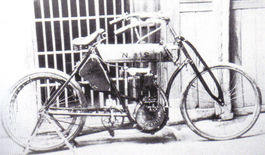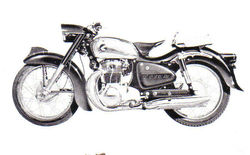A SHORT HISTORY OF THE JAPANESE MOTORCYCLE;
A Brief HistoryOf The Japanese Motorcycle:
The first motorcycle to ever operate in Japan was a German Hildebrand-Wolfmuller in 1896. The first motorcycle to be produced in Japan was the NS, built by N. Shimazu in 1909. His motorcycle was much like motorcycles from other countries which consisted of a bicycle frame with a "de Dion-Buton" type engine. As is generally known, the de Dion-Buton engine, built in France at the very end of the 1800's was the basic design copied by hundreds of early motorcycle builders on several continents. There were numerous small motorcycle builders in Japan, however most motorcycles were imported in the pre WWII era. The Americans and British were the major importers till the end of the 1930's. There were no more than 10 Japanese motorcycle builders prior to the mid 1940's. Riuko, a company building Harley Davidson clones was one of the major builders prior to the war. The primary history of the japanese motorcycle dates from the early 1950's to the early 1960's. After WWII, the industry came alive. Of the 140+ Japanese motorcycle manufactures which have existed, 96% were built after 1946 and most of those were gone by 1964. The big four, Honda, Yamaha, Suzuki, and Kawasaki are the only ones which remain. Other brands which might be recognized by many are Brigestone, Fuji, Hodaka, Mitsubishi (the car maker), Monarch, and Nissan (another car maker). The Japanese motorcycle became a dominant force in the world of motorcycle manufacturing for several reasons, first, after WWII, they began with "state of the art" factories while other countries had to resume business with their old factories and little money to modernize. Secondly, the Japanese copied the best of the motorcycles made at the time and improved upon already good designs. The German BMW, Adler, DKW and the British BSA, Norton, and Matchless were common models copied. This was significant because the existing American and European companies were stuck with their pre WWII technology and weaknesses while the Japanese counterpart could focus on reliability and better engineering. Thirdly, the Japanese could build better motorcycles at a much lower price. The cost of production for the Japanese motorcycles was much less than that of the US, British, or Germans. Another part of the production issue was the willingness of the Japanese worker to work within the goals of the company they worked for. American and European companies had to deal with the typical ongoing employee issues common in those countries often placing the worker in an adversarial position with their employer! One could argue that the former companies built better motorcycles but when a Japanese motorcycle could be purchased at a 30% or more reduction in price, the older companies found it hard to compete. Finally, the japanese companies became good at creating new markets. By building scooters to motorcycles at inexpenisve prices which were built well, were bright and new looking, and sold in large numbers, they were a formidable country to compete with. The reliability, lower cost, volume sales ability, and ability to build networks of dealers, made the Japanese companies a real challenge to the established companies.
The Japanese took the very best of the traditional designs from around the world, copied them and made them better. Money normally used for developing new products was used to make engines oil tight, more reliable, and with much better electrics. The first surprise that the west had, when purchasing Japanese bikes, was the reliability, durability, and ease of operation. As millions of bikes were sold during the late 1960's and 1970's, bikes were abused and often ridden with little service done to them.
The 1909 F.N. pictured below was much like what others did. Put an engine on a bicycle frame.
RIkou motorcycles were built from 1935 to 1962:
Rikuo built a variety of motorcycles, but are best known for their Harley Davidson "flat head" clone. Rikuo or "King of the Land" built one of the larger sized motorcycles in Japan. The bikes were also used as military motorcycles often with a sidecar.
Honda was a post-WWII motorcycle but quickly doninated the home market as well as becoming a major player in the world market:
Honda began making engine powered bicycles in 1948. By 1953 Honda was becoming a significant Japanese manufacturer. The 1953 SB350 pictured below was one of Honda's first major offerings. Honda began importing motorcycles into the US in 1959 and the rest is history. Honda continues to be the worlds largest producer of motorcycles building millions yearly. The US is now one of Honda's smaller markets.


